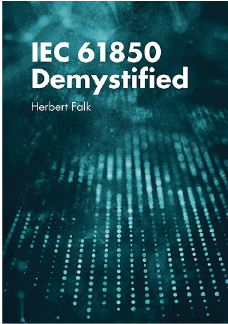First Edition

The electric power industry is going through a period of dramatic changes as a result of the wide-spread penetration of distributed energy resources and the need for their integration in a Smart Grid. The requirements for improved reliability, security and efficiency can be met only using advanced computer and communications technologies in protection, automation and control systems based on the IEC 61850 standard.
The standard has been around already for more than 15 years and there are thousands of substations around the world with various levels of its implementation. However, to a considerable number of protection and control specialist IEC 61850 still remains a mystery. That is why this book can help by demystifying the standard.
A very important factor is that the author – Herbert Falk, has been one of a limited number of key players involved in all stages of the development of MMS (Manufacturing Messaging Specification), UCA (Utility Communications Architecture) and IEC 61850. He has been and still is one of the editors of the standard and plays a leadership role in many of the new developments, especially related to cyber security.
The material in the more than 300 pages book is organized in twelve chapters and two appendices.
After the Introduction, the first chapter of the book focuses on what makes the IEC 61850 standard different, briefly describing some of the fundamental principles implemented in the development of the standard.
Chapter 2 is dedicated to the history of IEC 61850. It starts with an overview of the history of the evolution of computers and communications – the enabling technologies that llowed the development of industrial automation, followed by MMS, UCA 1 and 2 and finally IEC 61850.
Chapter 3 analyzes the need for speed in electric power system protection applications and compares using high-speed communications with hardwired interfaces.
The next chapter briefly describes the efforts to harmonize IEC 61850 and IEEE TR1550 in order to prevent the development of two similar, but different standards.
Chapter 5 describes the structure of the IEC 61850 Standard and its development process.
Chapter 6 is very important for the readers of the book, because it introduces the basic concepts of UML (Unified Modeling Language) and how it is used in the development of the standard and in this book.
The next two chapters describe the integration of client/server and publisher subscriber communications, followed by the principles of functional decomposition and hierarchical function models based on logical nodes and logical devices. The section on logical nodes and logical devices is the largest in the book with more than 100 pages.
A short Chapter 9 covers some of the base types defined in IEC 61850-7-2 and quality in IEC 61850-7-3.
One of the main differences between IEC 61850 and other communication standards is that it does not only define a communications protocol, but also a new engineering process which is presented in Chapter 10.
The next chapter concentrates on the use of MMS for Client and Server communications, followed by an analysis of the relationship between cyber security and IEC 61850.
The book is definitely a valuable resource for all PAC specialists that are becoming involved in the development of IEC 61850 based digital substations and the transition into a digital grid.
IEC 61850 Demystified
by Herbert Falk
ISBN-13: 978-1630813291
ISBN-10: 163081329X








